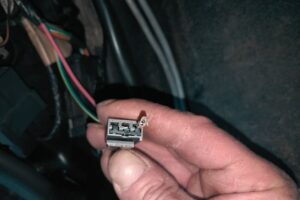Driving with snow chains on your tires is a great idea when the roads are covered in snow and ice. But will snow chains make your car slower? How fast can you drive with snow chains?
With snow chains on your tire, you should drive your car not more than 20 to 30 miles per hour (30 to 50 kilometers per hour). Even if you want to, your car will not be able to drive at its normal top speed on a snowy road with chains on the tire.
You should not try to drive faster than about 20-30mph with snow chains. If you go over a dry patch of the road, the chains can cause your car to slide out of control when steering or braking.
It is important that the snow chains are fitted properly on your tires. If not, your tires will develop minor cosmetic damage, especially if you speed up the car. Be safe and keep your speed below 30 mph when driving in snowy weather.
Read on to learn more about how fast you can drive with snow chains on and tips for driving safely with snow chains.
How Fast Can You Drive with Snow Chains?
Snow chains can be used up to 20-30mph (30-50km/hour). It would be difficult to drive faster than this in snowy conditions with snow chains, even if you want to. The traction on the snowy road prevents your car from going too fast.
Snow on the road and tire chains on your tires is not a normal driving condition. This situation negatively affects the fuel efficiency of your car, as well as its speed.
For your safety, you are required by your state authorities to use snow chains on your tires when driving on roads and streets under heavy snow. During such conditions, the fastest that you can go is no more than 20 to 30mph. Any faster than 20 to 30 mph with chains can cause your car to slide out of control when braking or steering.
There are car models that give specific details on how fast they could go on roads heavy with snow. But 20 to 30 mph. should be the average speed limit you should observe regardless of your car’s type and make.
The main reason why you are using snow chains is that the road condition is bad. The snow that is continuously falling makes it difficult for the road crew to keep up. The condition is already forcing you to drive slowly.
If you’re confident that you have properly installed the tire chains and that they won’t fall off, then you could drive normally. But ‘normally’ means normal speeds in snowy weather, not in sunshine conditions.
If you drive faster than 30 mph on snowy roads, you risk damage to the chains, tires, and your car. When the weather is so poor, making chains necessary for driving, you can’t drive faster than 35 mph.

Factors Affecting How Fast You Can Drive with Snow Chains
Below are some of the things that will limit your speed, even if your tires have chains in snowy roads and streets:
1. Actual Condition of the Road
If the snow on the road is already compacted, you can drive at a fairly fast speed but not too fast. But if there’s a fresh layer of snow on the road, you have to drive more slowly.
2. Fit of the Chain
If there’s a tight fit in the snow chain and the tire, there will be more grip on the road, and you can drive faster. But if it’s a loose fit, you have to drive slower. Be sure to use the right chains for the size of the tires.
3. Age of the Tire Chain
The newer the tire chain, the more confident you will be in using it, and the faster your car can go. The reverse will be true if you are using an old tire chain.
4. Experience
If this is your first time using a snow chain, you will tend to go slow. After using it several times, you will be more confident, and thus, be able to drive faster.
5. Type of Snow Chain
To some extent, the tire chain’s design can affect your speed while driving in the snow. Some snow chains cover the entire tire tread and tire walls, while some only cover part of the tire tread.
Safety Tips for Driving with Snow Chains
Snow chains can get you out of difficult situations in snowy weather, but not if you drive too fast. The main reason why tire chains are used is to give you a safe way to travel an unsafe road. Dangerous road conditions mean extra care in driving your car.
Here are some safety tips when you’re driving with snow chains:
1. Prepare Your Car
Before installing the tire chain, see to it that the tires are properly inflated. There should be at least three millimeters of tread in it. Better yet, use winter tires if you have them.
See that your brake locks are working and not frozen. If they are frozen, spray some WD-40 until they thaw. Bring along a shovel just in case you bog down on the snow.
2. Don’t Use Snow Chains on Roads Cleared of Ice or Snow
You will destroy the tire chain, your tires, and the road your car is running on. That means after you have gone through an icy road and ahead is a road cleared of ice and snow, you don’t have to drive with chains.
3. Use the Snow Chains on the Driven Wheels
You can use just one pair of tire chains, but it is better to use two pairs for better traction and grip. If only one pair is used, the snow chains are installed on the driven wheels.
Using only one pair will either cause your car to understeer or oversteer. If you have four-wheel drive, you need to cover all your tires with snow chains.
So if you have a front-wheel car, install the chains on the front wheels. Your car will oversteer if you put the chains only on the front wheels.
If yours is a rear-wheel drive, but the chains around the rear wheels. Your car will understeer if you put the chains only on the rear wheels.
4. Turn Off Traction Control/Anti-skid
If your tires are already covered with snow chains, turn off the car’s Traction Control/Anti-skid safety feature. To be sure, check your car operator’s manual.
5. Check the Fit of the Snow Chains
After installing the chains, don’t drive right away. Start the engine and gently shift from neutral to gear 1 (or Drive, if automatic) and drive slowly. After a short distance, stop and check the fit of the chains.
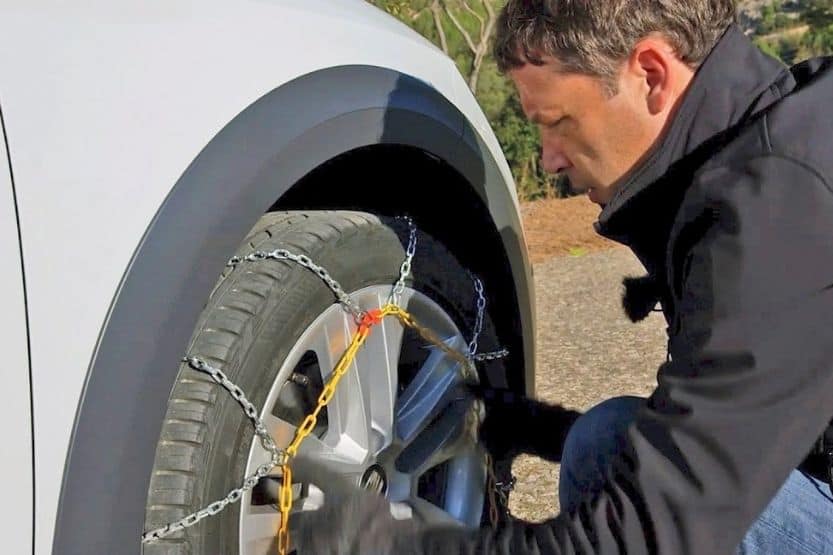
Adjust them if necessary so that they are securely fitted on the tires. They shouldn’t slip from the tires while your car is running.
6. Slowly Pull Away and Drive Gently
Keep your speed down and minimize sudden jerks on the steering wheel. Be particularly careful when negotiating bends and curves. Don’t step on the gas and the brakes abruptly. Drive as gently as the outside conditions allow.
7. Check the Chains After Your Trip
After using the chains, check if there are parts that are damaged during your trip. Look for links or connectors that are broken. Repair them if possible. If not, replace them with a new one.
8. Clean the Chains Before Storing
Clean and dry the snow chains before putting them in storage. Chains made of metal can corrode. It is important to get them dried completely before they are stored.
Again, how fast can you drive with chains? Your car can go as fast as 20 to 30 miles per hour (30 to 50 kilometers per hour) when it is equipped with snow chains. You won’t be able to drive much faster on snow and ice.
Don’t expect that you can normally drive; rather, expect that your speed will be reduced. Don’t try to drive faster than about 30mph, as this can cause your car to slide out of control.
Will Driving Too Fast with Snow Chains Damage the Tires or the Car?
If you drive too fast while your tires are wearing snow chains, you will cause minor damages to them. You can minimize the damage to the tires if you limit your speed below 30 mph.
And if you drive your car too fast and one of the tire chain snaps, it will damage your car’s body or chassis. The chain may even get entangled with the shock absorber and other parts of the car under the chassis.
Will Driving Too Fast Cause the Car to Slide Or Go Out of Control?
Yes, it could, so be prepared when you are driving on snow. It is frightening to have your car skidding. When this happens, try to remain calm and decide where you want the car to go.
Here are some steps you can do when this happens:
1. Don’t Slam on Breaks
Don’t slam on the breaks but steer the car gently in that direction. This can happen when you are running at 35 mph or more.
2. Slow Down
Slow down to keep your car from hydroplaning. Take your time before driving straightaway after a snowfall or rainfall. The road is slippery so wait until everything has settled before driving away.
3. Hold the Steering Wheel Tightly
Hold the steering wheel tightly with both your hands. The road is influencing how your car is turning, but you can control it by keeping a solid grip on the steering wheel.
It is when you are approaching or negotiating a bend that skids often happen. So be slow when you are nearing a corner.
4. Turn Off Cruise Control
Turn off your car’s cruise control when traveling on snow. Cruise control under snowy conditions can lead to skidding or hydroplaning. You can’t shift the car’s weight when it is in cruise control, and it can easily lose traction.
How to Install Tire Chains Properly to Ensure They Will Not Slip?
The snow chains must be fitted securely on the tires. If not, they can fall off when you are driving fast. It would help if you practiced how to install the snow chains on your tires. It is relatively easy to do. In installing the chains, use a pair of gloves and a pair of tire tensioners.
Here are the steps you can follow to do this:
1. Untangle the Chains from the Box or Pack
Get the chains from the pack or box and make sure that the chains are straightened out and not looping over one another. Hold them up so that one end is in your right hand and the other end is in your left hand.
You should see the metal latches along the two sections of the chains. The latches and hooks of the chains are usually color-coded to help you connect the same colors together.
You should connect them in such a way that they will not cause any damage to your tires. To be sure, follow the instructions on the chain pack or box.
2. Lay the Chains Over the Tire
Lay the chains on the ground in front of the tire. The latches should be on each side of the tire. The tires should not run over them.
3. Drive the Tire Over the Chain
Start the car and drive it forward so that the chain is directly under the tire. Stop the engine and cover the tire with the tire chain. Connect the latches on either side of the chain.
If you need to turn the wheel toward the inside of the car, you can easily access the chain’s connecting points inside the wheel.
If you install the chain on the right tire, turn the steering wheel on the left and vice versa if you install the chain on the left tire. Put the car on the parking brake so that it won’t move forward or backward.
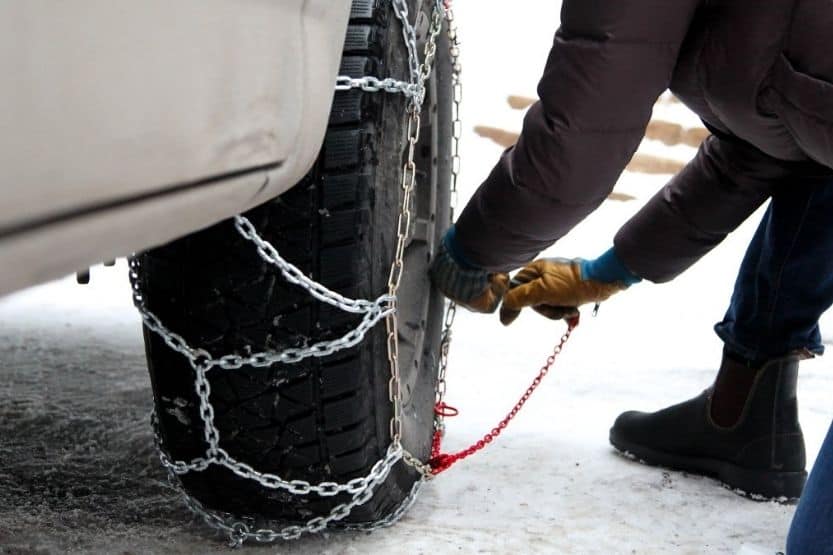
4. Connect Both Ends of the Chain
Connect the hooked edges of the chain in the inner part of the tire. Then connect the hooked edges on the outside section of the tire.
Rotate the tightening cam or closing link so that the chains will be tight enough. This will ensure it won’t slip from the tire when the car is running. Make sure that the links of the chain are evenly distributed throughout the tire.
Will Snow Chains Damage the Tires or the Car?
It would help if you only covered your tires with chains when traversing a road-heavy laden with snow. Using it unnecessarily will damage your tires and your car, and the road you are traveling on. Using a snow chain that is not suited to your tire’s size will also damage your tires.
Conclusion: How Fast Can You Drive with Chains?
Your car should go about 20 to 30 mph (30 to 50 kilometers per hour) with snow chains on the tires.
Don’t make the mistake of thinking that you can normally drive with snow chains on your tires. When your tires are wearing snow chains, you will notice that your car will not be able to reach its top speed.
If you drive over a dry spot of the road with snow chains, your car can slide out of control when braking or steering.
Be safe and keep your speed below 30 mph. when driving in snowy weather.
Related reading:
How to Drive in Snow Safely [9 Tips]
How to Put on Snow Chains? [Easy Snow Chain Install]

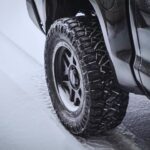
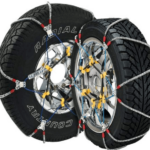

![Kawasaki Ninja 250 Top Speed [How Fast Can It Go?] kawasaki ninja 250 top speed](https://roadsumo.com/wp-content/uploads/2022/06/Kawasaki-Ninja-250-top-speed-150x150.jpg)

![How to Put Chains on Tires [Easy Steps] how to put chains on tires](https://roadsumo.com/wp-content/uploads/2022/01/how-to-put-chains-on-tires-150x150.jpg)


